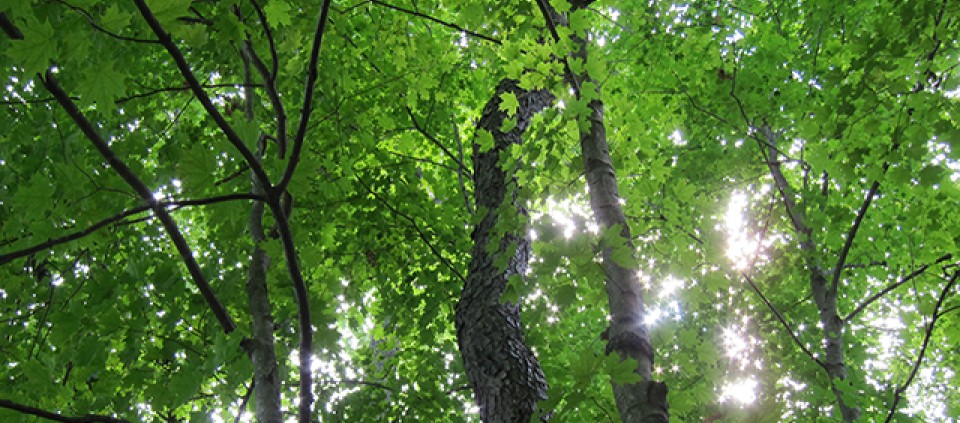Drawing Closer to Nature

On the fourth day of a weeklong course for artists and art teachers, I brought a group of 20 adults to the woods not far from our campus. A few hundred yards into the nature preserve, we stopped at a pretty place underneath some giant pines. A stream nearby could just be heard over the hum of the breeze. On this sunny summer day, in the companionship of (now) dear and trusted friends, we sat a while and spoke of the history of these woods, and what our task would be for the afternoon.
It would be the Encounter, a blind walk done in pairs. With closed eyes, one partner is introduced to her surroundings through the careful guidance of the sighted partner; then they switch. I demonstrated with a participant how one might guide the other, ever mindful of the responsibilities now entrusted to them. Each person would have about five minutes, and the blind partner would establish the pace of the journey. I would remain sighted at the starting spot.
The invitation was initially met with nervous titters, tentative partnerships, and hesitant baby steps by all. Every one of these competent adults—who had faced the truly terrifying worlds of childhood, adolescence, marriage, classrooms, raising families, and driving in traffic, and who were well acquainted with trees and brooks and summer—became self-conscious and clearly frightened when they were asked to walk into raw nature stripped of their sense of sight. Invited to hold on to a sighted partner as closely as they felt necessary, to move as slowly as they wished, walking in a place they had just walked through, for a prescribed five-minute interval, they found that all these safety precautions were still not sufficient to allay their fears.
One woman, a courageous art teacher of junior high school students, sat where she was and chose not to engage in the process. I approached her and asked if I might be of assistance. “I can’t do this,” she said. “I cannot close my eyes in the out-of-doors.” I replied that she needn’t participate, or could modify the exercise according to her own threshold of comfort.
More silence; then, “I would like to feel comfortable enough in nature to be able to just sit here with my eyes closed for a while.” I affirmed her choice and moved to sit a few yards away. A short time later, she called to me and, weeping, repeated, “I can’t do this. I can’t close my eyes and sit quietly, even knowing that the teacher is right nearby. I can hardly breathe thinking that, without my eyes open to warn me, something from the forest will come out and hurt me. This is no way to be! Please sit by my side and hold my hand, and then maybe I’ll be able to close my eyes.”
I sat by her side, I held her hand. She sat and tried to breathe calmly. After a while, she put the other hand first on her heart, then on the earth. Then she closed her eyes. We sat there for a while; she rocked lightly back and forth and wept quietly. After some time, she stopped weeping, and calm came over her face. She straightened her back, released my hand, thanked me, then put both her hands on the earth, and said, “Thank you,” as she lifted her face to the dappled light filtering through the pines.
She thanked the handful of earth, twigs, and pine needles that she brought up to her face to smell and touch. She slowly breathed in the aroma of the forest, then slowly exhaled. She lay face down on the earth, her arms wide out, her fingers caressing the earth. Her face became muddy, mixing her tears with the earth. She stayed there while the others were finding their own rites of return.
When she sat up at last, she didn’t brush the dirt off. She remained quiet while the others arrived back at our meeting place, chatting enthusiastically about their own Encounters. As we gathered around, as we customarily do, to exchange the news of our forays, this woman was attentive to the triumphs of others, but chose to remain silent. On the way back, several people remarked on what a pretty face she had.
Do not be afraid. Despite what you may have been told about the nature of nature, trust in your own experiences. See for yourself. This is your home.
© Kripalu Center for Yoga & Health. All rights reserved. To request permission to reprint, please e-mail editor@kripalu.org.
Peter London is an artist, master teacher, and author of Drawing Closer to Nature and No More Secondhand Art.
Full Bio and Programs